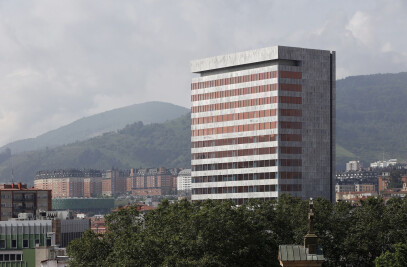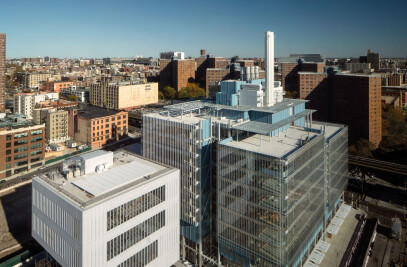Partial demolition and renovation: classical 19th century brickwork and structural glazing with high-end solar control glass / Revitalizing Dublin
"The times, they are a-changin’", sang Bob Dylan in 1964, continuing: "Come writers and critics, who prophesize with your pens, and keep your eyes wide… ‘cause the times they are a-changin’.” These words might spring to the mind of someone looking at the former headquarters of The Irish Times in Dublin, where futuristic glass architecture merges with classical brickwork from the 19th century. The historic building of the Irish newspaper has been partially demolished and partially renovated. A glass atrium links it to the modern architecture of Fleet Street. The clear geometric structures and the 2,200 square metres of structural glazing with ipasol neutral solar control glass from Interpane ensure that the interior is flooded with daylight but protected from the summer heat.
Temple Bar, the cultural heart of Dublin, on the south bank of the Liffey. Cobbled streets that come alive at night. The district has a lively history: it is over 400 years old, and was a central trading hub in the old Dublin. It lost its importance during the 19th century, and by the 1960s had fallen into disrepair – in some places into ruin. In the 1980s the national transportation company Córas Iompair Éireann planned to purchase the area in order to tear it down and build a central bus station. Rents plummeted. Perhaps this is what saved Temple Bar. The low rents attracted artists, galleries and small shops. The district sprang back to life. Finally, the bus station project was cancelled and instead the regeneration of the area was pushed forward. Temple Bar was turned into a cultural centre, which now hosts numerous Irish cultural institutions like the Irish Film Centre and the national acting school – but also the Central Bank of Ireland.
Modern glass façade and solid brickwork
The Irish Times was founded in 1859 by Irish Unionists. In 1895 it moved into the building on D’Olier Street, at the corner of Fleet Street, in Temple Bar. Over 100 years later, in 2007, the newspaper moved into a modern office building just 100 metres from the historic site. The construction company P. Elliott bought the run-down building and with the help of HKR Architects they demolished some parts, renovated others and added the large glass atrium which connects the old buildings structurally and visually to the modern shops on Fleet Street. The architectonic mix of old and modern space is now an office building. l
Structural glazing: Lots of sunlight, high solar control
The ipasol neutral full-glass façade fulfils the highest functional and aesthetic requirements. It provides colour-neutral transparency, plenty of daylight and high solar control. The energetic properties of the glazing ensure energy-efficient heating, cooling and lighting, which reduces running costs and protects the environment. Visually, the façade is also impressive with its staggered appearance - parts of the glazing lean out over the street. The structural glazing gives the building a filigree look despite its size. The offices inside have sufficient sight-screening, however. The tops and bottoms of the panes are fully or partially enamelled. The complex structure consists of tempered safety glass, thermally toughened glass and laminated safety glass, providing high security. The construction was undertaken by Williaam Cox Ltd. of Dublin.
Interpane’s ipasol coating delivers 68% daylight transmittance and a solar factor of 37% in a standard insulating glass construction. Due to the different glass types used in the façade (tempered safety glass, thermally toughened glass and laminated safety glass), the values differ slightly: in most parts of the building, the solar factor is 36% (according to EN 410). The sun’s rays don’t heat up the rooms behind the glass so much, saving on air conditioning and on the need for outside shading. Nevertheless, the rooms still receive an unusually high amount of daylight (V = 64%), so that the electric lighting is turned on relatively late. The offices are also protected from the sounds of the street: the glass has a sound reduction index RW = 44 dB. External light reflectance ranges from 8 – 15%, giving a very colour-neutral outer appearance and very high transparency. The reflectance on the inside is 8 – 14%. The view from the inside outwards is therefore outstanding, even at night when the lights are on. In the winter, the Ug-value of 1.1 W/(m²K) (according to EN 673) provides effective thermal insulation..































